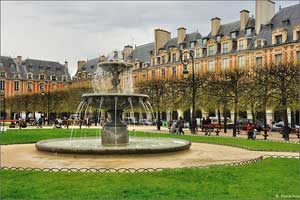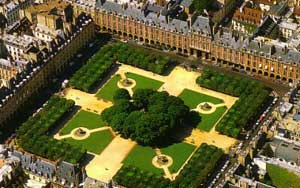Today the Places des Vosges is widely considered the most beautiful square in Paris, if not the world.
The harmonious symmetry of the buildings, the up-market boutiques and galleries that fill the arcades and the peaceful atmosphere all combine to make it a favorite haunt amongst the most discerning Parisians.
On any sunny day the square will be filled with Parisians lunching and reading, children playing and young couples swooning.
These days the serene atmosphere is only pierced now and again by the playful squeal of a child but in the past the Place des Vosges has been home to some pivotal events in history.
With a royal palace, the death of a king and a star-studded list of residents in its past, the Place des Vosges has some stories to tell.

At the beginning of the 14th century, what would later become the Hotel des Tournelles was nothing more than a house on the northen side of what would become the Place des Vosges.
It was built by Pierre d'Orgemont, chancellor of France under King Charles VI in 1388. A long line of inheriting and house-swapping ensued so by 1417 the building was the property of King Charles VI, either called the Beloved, or the Mad, whatever your angle.
From then on the Hôtel des Tournelles was used sporadically by the reigning monarch.
By 1515 François I was King but he preferred to live in the Louvre and his chateau in the Loire valley. He did, however, lodge his mother, along with his mistress in the Hôtel des Tournelles. This tradition of using the Hôtel as a residence for royal mistresses must have appealed to Henri II because he in turn gave the residence to his mistress, Diane de Poitiers.
Henri celebrated his coronation in 1547 in the Hôtel des Tournelles which was only the first of the many fetes the building would see during his reign. In 1559 Henri threw the most extravagant party the Hôtel had ever seen, but it would also be the last.
Hundreds of guests gathered to celebrate the double wedding of Élisabeth of France with Philip II of Spain and the King's sister, Marguerite of France with the Duke of Savoy.
It promised to be the most spectacular celebration that the King had ever organised and to mark the occasion a tournament was organised on the largest road in Paris, rue Saint-Antoine.
Henri II himself was taking part in the competition but during a joust that was happening in front of the Hôtel Sully, the King received a sharp blow to head from his opponants lance. Henri was immediately transported to the Hôtel des Tournelles but his injuries were fatal.
After 10 days of agony and multiple surgeries, Henri II died on 10th July 1559.
His wife, Queen Catherine de Médicis had never cared for the gothic Hôtel des Tournelles and so used her husband's death as a pretext for moving the royal family to the Louvre. Presented as a wife distraught with grief who could not bear to stay in the house where her husband died, it was rumoured that she did it to spite the King's long-adored mistress, Diane de Poitiers.
Catherine de Médici had the Gothic pile demolished and removed to the Louvre.
The Place des Vosges, as we know it, was officially inaugaurated in 1612 as the 'Place Royal'. At that time it was nothing more than a lawn that was frequently used for duels.
Two pavillions were built on the north and south faces of the square and although there were dedicated the pavillions of the King and of the Queen, no royality has ever lived in the square.

During the Revolution, Cardinal Richelieu's carefully placed statue of Louis XIII was torn down (unsurprisingly) and melted.
To support the campaigns of his Revolutionary Army Napoleon called a tax in 1799. The department of Vosges was the first department in France to stump up the money, so to show his gratitude for their loyality and efficiency, Napoleon changed the name from 'Place Royale' to 'Place des Vosges'.
It was renamed Place Royale during the Restoration in 1815, but the short-lived Second Republic restored the revolutionary one in 1848.